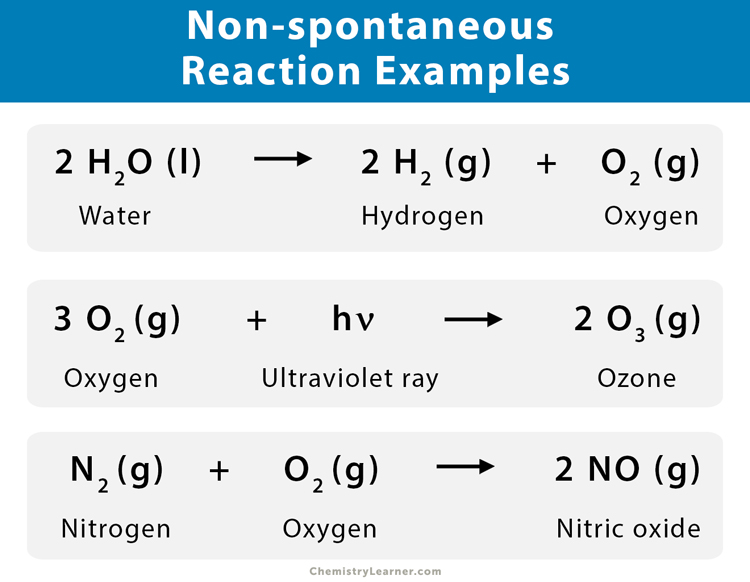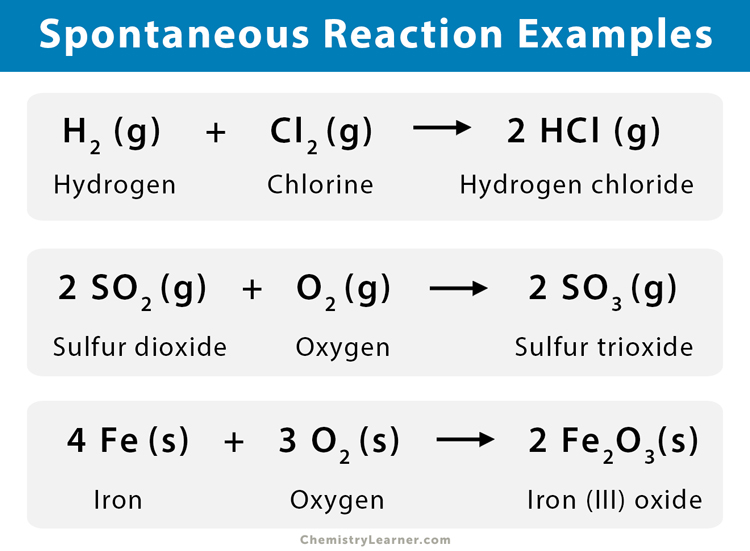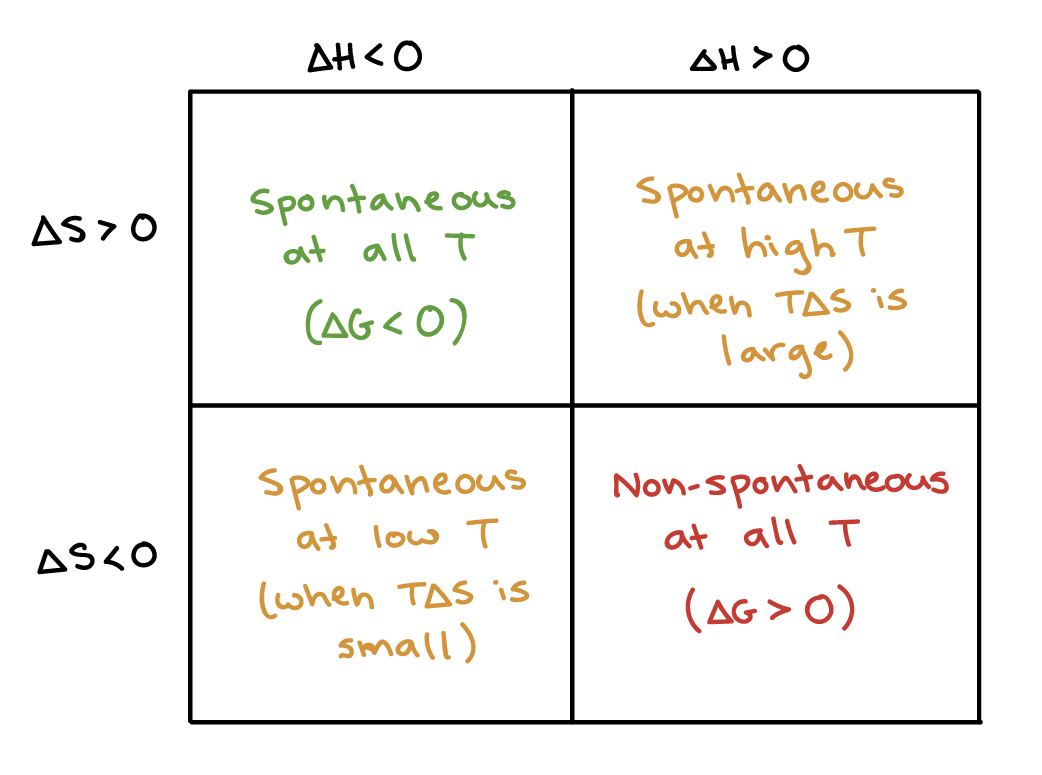How to Determine if Spontaneous or Nonspontaneous
How to identify if a redox reaction is spontaneous or nonspontaneous. How does Gibbs energy enthalpy and entropy determine whether a process will be a spontaneous or nonspontaneous reaction.

Spontaneous And Non Spontaneous Reaction Definition And Examples
G177-T0161 Now we have to find the temperature for which this reaction is spontaneousnon-spontaneousequilibrium.

. When delta H is negative and delta S is positive reaction is spontaneous at all temperatures When delta H is positive and delta S is negative reaction is spontaneous at al. If delta G is positive a reaction is nonspontaneous. The key difference between spontaneous and nonspontaneous reactions is that the spontaneous reactions have a negative Gibbs free energy whereas the non-spontaneous reactions have a positive Gibbs free energy.
There is no net change. Ect Question 7 Determine whether the reaction is spontaneous or nonspontaneous for the cell schematic as written. The total energy of the products of a spontaneous reaction is less than that of the reactants.
If E o for the redox reaction as written is negative the reaction DOES NOT proceed in the forward direction and is said to be non-spontaneous. If delta G is negative a reaction is spontaneous and will occur. Does the entropy of the universe increase.
If you do not know the value of G then you could also look at entropy which is the opposite. The entropy of the system increases during a combustion reaction. Total Energy of the Products.
Free energy delta G is a measurement of the enthalpy and entropy of a chemical reaction. The total energy of the products of a nonspontaneous reaction is higher than that of. This indicates how strong in.
When Δ H is positive and Δ S is negative the sign of Δ G will always be positive and the reaction can never be spontaneous. 4 posts Page 1 of 1. The easiest way to tell whether a reaction is spontaneous or not is by looking at the value of the Gibbs free energy.
When Δ H is negative and Δ S is positive the sign of Δ G will always be negative and the reaction will be spontaneous at all temperatures. A reaction which is exothermic ΔH negative and results in an increase in the entropy of the system ΔS positive will always be spontaneous. How do you know if the reaction is spontaneous or non spontaneous.
Postby 205282258 Mon Feb 21 2022 628 am. Describe how the signs of delta H and delta S determine whether a reaction is spontaneous or nonspontaneous at constant temperature and pressure. If 0 the system is at equilibrium.
Defines spontaneous and nonspontaneous reactions in terms of entropy and enthalpy. If you need further clarification then just comment below These values can now be plugged into the Gibbs-free energy equation. Practice Spontaneous and Nonspontaneous Reactions.
There are two types of processes or reactions. Based on an equation you can find the standard cell potential of the whole cell by subtracting the sums of E products - E reactants. The combination of energy decrease and entropy increase dictates that combustion reactions are spontaneous reactions.
The entropy of the universe strives toward a maximum. We can determine if a reaction is spontaneous or non-spontaneous by looking at the Gibbs-free energy of the reaction. This corresponds to both driving forces being in favor of product formation.
A reactions spontaneity ie if it occurs can be deduced from the Gibbs-free energy values. If G is negative then it is a spontaneous reaction a positive G means the reaction is not spontaneous. If E o for the redox reaction as written is positive the reaction proceeds in the forward direction and is said to be spontaneous.
The mathematical formula for Gibbs free energy is given by. A nonspontaneous reaction is a reaction that does not favor the formation of products at the given set of conditions. Spontaneous and Nonspontaneous Reactions.
And to correlate E to G you can use E standard - delta G standardnF or delta G -nFE. If is positive the reaction is nonspontaneous it proceeds in the reverse direction. Spontaneous ReactionsReactions are favorable when they result in a decrease in enthalpy and an increase in entropy of the systemWhen both of these conditions are met the reaction occurs naturally.
In order to tell if a reaction is spontaneous you must ask one simple question. The sign convention of changes in free energy follows the general convention for thermodynamic measurements. If is negative the reaction is spontaneous it proceeds in the forward direction.
ΔGΔHTΔS Where ΔG Gibbs free energy ΔH Enthalpy change. Spontaneous changes also called natural processes proceed when left to themselves and in the absence of any attempt to drive them in reverse. In order for a reaction to be nonspontaneous it must be endothermic accompanied by a.
Is there a state function of the system that can tell us whether a process. Thereforeif there is a decrease in the entropy of the universe the process cannot happen. This problem has been solved.
Check all that apply. Consider the combustion of a fuel like ethanol C 2 H 5 OH l in oxygen gas O 2g in air. Fe s 1 M FeCl₂ aq 1 M AI NO33 aq Al s spontaneous nonspontaneous.
How does Gibbs energy enthalpy and entropy determine whether a process will be a spontaneous or nonspontaneous reaction. See the answer See the answer See the answer done loading.

Spontaneous And Non Spontaneous Reaction Definition And Examples

Gibbs Free Energy And Spontaneity Article Khan Academy
Spontaneity Free Energy And Temperature Introductory Chemistry

0 Response to "How to Determine if Spontaneous or Nonspontaneous"
Post a Comment